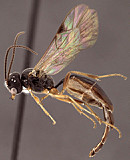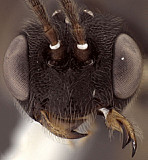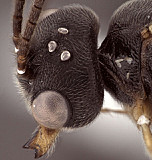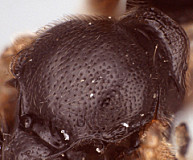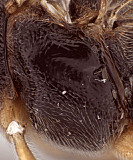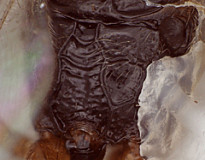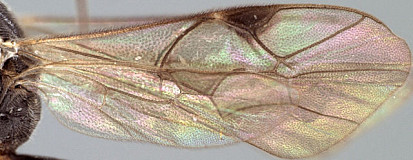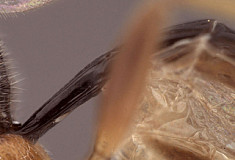Clypeus (Fig. 2) strongly bulging, protruding in profile; ventral margin blunt, evenly convex; epistomal sulcus weakly separating clypeus from even more strongly bulging face. Malar space distinctly shorter than half basal width of mandible. Mandible (Figs 2, 3) very broad basally, with strong transverse, basal indentation, curved, strongly narrowing from base to middle, parallel-sided from midpoint to apex; ventral tooth usually about same size as dorsal tooth; ventral margin carinate; surface on basal half with diagonal ridge extending medially from dorso-basal corner. Frons with elevated carina along midline (Fig. 3). Female and male ocelli very small (Fig. 3), with maximum diameter of lateral ocellus distinctly shorter than distance between ocellus and eye. Female antennae much shorter than body (Fig. 1), first flagellomere not much longer than second. Hypostomal carina joining occipital carina a little above base of mandible; occipital carina complete. Epomia very well developed. Dorsal end of epicnemial carina extending towards anterior margin of mesopleuron but then extending parallel to it dorsally (Fig. 5), less commonly weakly separated from anterior margin; mesopleuron finely mat or polished, finely punctate. Notaulus essentially absent though punctation along notaular lines may be denser (Fig. 4). Small but distinct u-shaped groove present in lateral view between anterior end of lateral, longitudinal carina of propodeum and posterior margin of metathorax. Pleural carina very well-developed throughout; propodeal carinae complete: lateral and neduan longitudinal carinae well-developed throughout, fused posteriorly to form part of lateral margin of petiolar area; anterior and posterior transverse carinae also well-developed and complete except posterior transverse carinae sometimes indistinct among series of transverse ridges within petiolar area + areola (Fig. 6); when distinct, petiolar area and areola broad and well delineated, basal median area distinctly smaller. Legs with apical comb on posterior side of hind tibia present, short, moderately dense; hind tibial spurs slender (Fig. 1), longest spur about 0.4-0.5 times length of hind basitarsus; tarsal claws simple. Fore wing (Fig. 7) with areolet either present or absent (present in single female examined, absent in single male examined); stigma short, broad, Rs+2r arising from or near midpoint. Hind wing (Fig. 7) with first abscissa of CU1 longer than 1cu-a. T1 (Figs 7, 8) long, narrow, approximately parallel-sided over basal 0.45, abruptly broadening posteriorly as in Fig. 8; dorsal carinae varying from absent or not readily apparent to weakly elevated as low, short ridges medially; dorsal-lateral carina not apparent between spiracle and posterior margin; basal depression of dorsal tendon attachment absent; glymma absent. S1 not extending to level of spiracle, about 0.4-0.45 times length of T1. T2 thyridium absent; T2 and T3 exceptionally long, both in male (Fig. 10) and female (Fig. 1); laterotergites of T2 and T3 completely separated by creases in males, T2 separated by crease to level of spiracle in female, remainder of T2 and all of T3 pendulous; T3 of female with posterior margin narrow and deeply excised. Ovipositor (Figs 1, 11) short, upcurved, with deep subapical, dorsal notch; ovipositor sheath weakly clavate, but not as broad as in most
Saotis. Apex of female metasoma as in Fig. 1: apical portion of female metasoma long and strongly compressed; female subgenital plate and at least two preceding sterna very long, desclerotized, and folded along midline.
This description is considerably modified from Townes (1971) and based on one female and one male in the Texas A&M University Collection.

